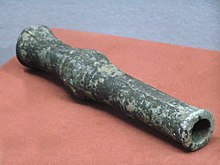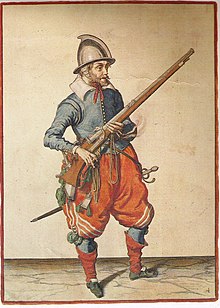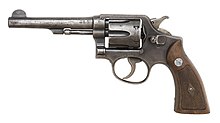A
gun is a normally tubular
weapon or other device designed to discharge
projectiles or other material.
[1] The projectile may be solid, liquid, gas or energy and may be free, as with bullets and artillery shells, or captive as with
Taser probes and
whaling harpoons. The means of projection varies according to design but is usually effected by the action of gas pressure, either produced through the rapid combustion of a
propellant or compressed and stored by mechanical means, operating on the projectile inside an open-ended tube in the fashion of a piston. The confined gas accelerates the movable projectile down the length of the tube imparting sufficient velocity to sustain the projectile's travel once the action of the gas ceases at the end of the tube or muzzle. Alternatively, acceleration via electromagnetic field generation may be employed in which case the tube may be dispensed with and a guide rail substituted.
The first devices identified as guns appeared in
China around 1000AD, and by the 12th century the technology was spreading through the rest of Asia, and into Europe by the 13th century.
[2]
Etymology
The origin of the English word
gun is presently considered to derive from the name given to a particular historical weapon.
Domina Gunildawas the name given to a remarkably large
ballista, a mechanical bolt throwing weapon of enormous size, mounted at
Windsor Castleduring the 14C. This name in turn may have derived from the
Old Norse woman's proper name
Gunnhildr which combines two Norse words referring to battle.
[3] In any case the term
gonne or
gunne was applied to early hand-held firearms by the late 14C. or early 15C.
History
The first device identified as a gun, a bamboo tube that used gunpowder to fire a spear, appeared in
China around 1000AD.
[4] The Chinese had previously invented
gunpowder in the 9th century.
[5][6][7] An early type of
firearm (or portable gun) is the
fire lance, a black-powder–filled tube attached to the end of a spear and used as a
flamethrower;
shrapnel was sometimes placed in the barrel so that it would fly out together with the flames.
[7][8] The earliest depiction of a gunpowder weapon is the illustration of a fire-lance on a mid-10th century silk banner from Dunhuang.
[9] The
De'an Shoucheng Lu, an account of the
siege of De'an in 1132, records that
Song forces used fire-lances against the
Jurchens.
[10] In due course, the proportion of
saltpeterin the propellant was increased to maximise its explosive power.
[8] To better withstand that explosive power, the paper and
bamboo of which fire-lance barrels were originally made came to be replaced by metal.
[7] And to take full advantage of that power, the shrapnel came to be replaced by projectiles whose size and shape filled the barrel more closely.
[8] With this, we have the three basic features of the gun: a barrel made of metal, high-
nitrate gunpowder, and a projectile which totally occludes the
muzzle so that the powder charge exerts its full potential in propellant effect.
[11]
One theory of how gunpowder came to
Europe is that it made its way along the
Silk Roadthrough the Middle East; another is that it was brought to Europe during the Mongol invasion in the first half of the 13th century.
[12][13] English Privy Wardrobe accounts list "ribaldis," a type of cannon, in the 1340s, and siege guns were used by the English at
Calais in 1346.
[14] The earliest surviving firearm in Europe has been found from
Otepää,
Estonia and it dates to at least 1396.
[15] Around the late 14th century in Europe, smaller and portable hand-held
cannons were developed, creating in effect the first smooth-bore personal firearm. In the late 15th century the
Ottoman empire used firearms as part of its regular infantry.
The first successful rapid-fire firearm is the Gatling Gun, invented by Richard Gatling and fielded by the Union forces during the American Civil War in the 1860s. The world's first sub-machine gun (a fully automatic firearm which fires pistol cartridges) able to be maneuvered by a single soldier is the MP18.1, invented by
Theodor Bergmann. It was introduced into service in 1918 by the German Army during World War I as the primary weapon of the The Stosstruppen (assault groups specialized in trench combat). The first assault rifle was introduced during
World War IIby the Germans, known as the StG44. It was the first-ever firearm which bridges the gap between long range rifles, machine guns and short range sub-machine guns. Since the mid-20th century guns that fire beams of energy rather than solid projectiles have been developed, and also guns that can be fired by means other than the use of gunpowder.
Operating principle
Most guns use compressed gas confined by the barrel to propel the bullet up to high speed, though devices operating in other ways are sometimes called guns. In firearms that are gun the high-pressure gas is generated by combustion, usually of
gunpowder. This principle is similar to that of
internal combustion engines, except that the bullet leaves the barrel, while the piston transfers its motion to other parts and returns down the cylinder. As in an internal combustion engine, the combustion propagates by
deflagration rather than by
detonation, and the optimal
gunpowder, like the optimal motor fuel, is resistant to detonation. This is because much of the energy generated in detonation is in the form of a
shock wave, which can propagate from the gas to the solid structure and heat or damage the structure, rather than staying as heat to propel the piston or bullet. The shock wave at such high temperature and pressure is much faster than that of any bullet, and would leave the gun as
sound either through the barrel or the bullet itself rather than contributing to the bullet's velocity.
Components
Barrel
Barrel types include
rifled—a series of spiraled grooves or angles within the barrel—when the projectile requires an induced spin to stabilize it, and
smoothbore when the projectile is stabilized by other means or rifling is undesired or unnecessary. Typically, interior barrel diameter and the associated projectile size is a means to identify gun variations. Bore diameter is reported in several ways. The more conventional measure is reporting the interior diameter (bore) of the barrel in decimal fractions of the inch or in millimetres. Some guns—such as
shotguns—report the weapon's
gauge (which is the number of shot pellets having the same diameter as the bore produced from one English pound (454g) of lead) or—as in some British ordnance—the weight of the weapon's usual projectile.
Projectile
A gun projectile may be a simple, single-piece item like a bullet, a casing containing a payload like a shotshell or explosive shell, or complex projectile like a sub-caliber projectile and sabot. The propellant may be air, an explosive solid, or an explosive liquid. Some variations like the
Gyrojet and certain other types combine the projectile and propellant into a single item.
Terminology
The term gun may refer to any sort of projectile weapon from large cannons to small
firearms including those that are usually hand-held (
handgun).
[16] The word gun is also commonly used to describe objects which, while they are not themselves weapons, produce an effect or possess a form which is in some way evocative of a handgun or
long gun.
The use of the term "
cannon" is interchangeable with "gun" as words borrowed from the French language during the early 15th century, from
Old French canon, itself a borrowing from the Italian
cannone, a "large tube" augmentative of Latin
canna "reed or cane".
[17] Recent scholarship indicates that the term "gun" may have its origins in the
Norse woman's name "Gunnildr" (
or "Gunnild", possibly QueenGunhild of Wenden, wife of King Sweyn Forkbeard[citation needed]), which was often shortened to "Gunna". The earliest recorded use of the term "gonne" was in a Latin document circa 1339. Other names for guns during this era were "schioppi" (Italian translation-"thunderers"), and "donrebusse" (Dutch translation-"thunder gun") which was incorporated into the English language as "blunderbuss".Artillerymen were often referred to as "gonners" and "artillers" Early guns and the men who used them were often associated with the devil and the gunner's craft was considered a
black art, a point reinforced by the smell of
sulfur on battlefields created from the firing of guns along with the
muzzle blast and accompanying
flash.
The word
cannon is retained in some cases for the actual gun tube but not the weapon system. The title gunner is applied to the member of the team charged with operating, aiming, and firing a gun.
Autocannons are automatic guns designed primarily to fire shells and are mounted on a vehicle or other mount.
Machine guns are similar, but usually designed to fire simple projectiles. In some calibers and some usages, these two definitions overlap.
In contemporary military and naval parlance the term gun has a very specific meaning and refers solely to any large-calibre, direct-fire, high-velocity, flat-trajectory artillery piece employing an explosive-filled hollowed metal
shell or
solid bolt as its primary projectile.
[citation needed] This later usage contrasts with large-calibre, high-angle, low-velocity, indirect-fire weapons such as
howitzers,
mortars, and
grenade launchers which invariantly employ explosive-filled shells. In other military use, the term "gun" refers primarily to
direct fire weapons that capitalize on their
muzzle velocity for penetration or range. In modern parlance, these weapons are
breech-loadedand built primarily for long range fire with a low or almost flat
ballistic arc. A variation is the
howitzer or gun-howitzer designed to offer the ability to fire both low or high-angle ballistic arcs. In this use, example guns include
naval guns. A less strict application of the word is to identify one artillery weapon system or non-machine gun projectile armament on aircraft.
A related military use of the word is in describing
gun-type fission weapon. In this instance, the "gun" is part of a
nuclear weapon and contains an explosively propelled sub-critical slug of
fissile material within a barrel to be fired into a second sub-critical mass in order to initiate the fission reaction. Potentially confused with this usage are small nuclear devices capable of being fired by artillery or
recoilless rifle.
Shotguns are normally civilian weapons used primarily for hunting. These weapons are typically smooth bored and fire a shell containing small lead or steel balls. Variations use rifled barrels or fire other projectiles including solid lead slugs, a
Taser XREP projectile capable of stunning a target, or other payloads. In military versions, these weapons are often used to burst door hinges or locks in addition to antipersonnel uses.
Types of guns
Military guns
Machine guns

The
Heckler & Koch MP5 submachine gun is widely used by law enforcement tactical teams and military forces.
Handguns
Autocannon guns
Artillery guns
Tank guns
Hunting guns
Rescue equipment guns
Training and entertainment guns
Fictional guns
See also













